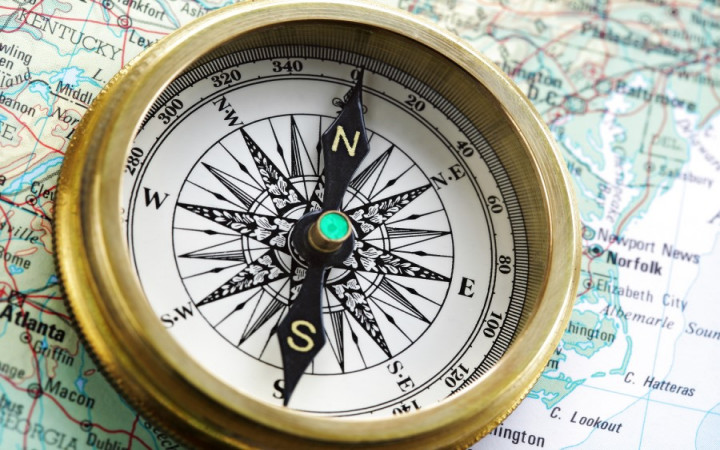How to Use a Compass Like Like a Pro Design

SOCIAL STUDIES — Explorers
Have You Ever Wondered...
- How does a compass work?
- In which direction does a compass point?
- How does magnetic north differ from true north?
Imagine you're an explorer from the distant past. Perhaps you're a compatriot of Daniel Boone or a member of the Lewis and Clark expedition. You're about to leave your river camp and hike off into dense forests in search of what lies to the west.
Once you make your way under the dense canopy of trees, you quickly lose sight of the river. You also lose sight of nearby landmarks, such as the mountains you just passed through. Before long you're surrounded by trees and it can be easy to get turned around.
You're in charge of leading everyone in the right direction, but how can you be sure which direction is correct? If it was the modern day, you could pull out your handheld Global Positioning System (GPS) device and allow satellites circling Earth to pinpoint your exact location.
Unfortunately, GPS is a relatively new invention. Frontier explorers had to rely upon a different piece of technology that, oddly enough, is still used as a valuable tool by modern explorers. What are we talking about? The compass, of course!
If you've ever seen a compass, you know that it's usually a simple round object that contains a small, lightweight magnet (usually called a needle because of its shape) that is balanced on a pivot point that allows it to move freely. One end of the needle is often marked with an "N" for north, since that end of the needle always points toward the North Pole.
How cool is it that such a simple magnetic object exists that can tell you which direction north is no matter where you happen to be on Earth? Compasses work so effortlessly because their design allows the magnet to respond freely to Earth's magnetic field.
Earth itself is like a giant magnet that creates its own magnetic field. The north end of a compass is drawn to align with Earth's magnetic North Pole. As explorers have always known, you can orient yourself and travel purposefully in a specific direction as long as you know which way north is!
If you need to use a compass to navigate thousands of miles, it's important to know that there's a difference between Earth's magnetic North Pole (where a compass points) and "true north," which is Earth's geographic location known as the North Pole. Earth's magnetic North Pole is actually about 1,000 miles south of the geographic North Pole.
Further complicating navigating by compass is the fact that Earth's magnetic North Pole can move. Earth's magnetic field can change over time. As it does so, the magnetic North Pole moves. Scientists at Oregon State University believe that the magnetic North Pole has moved over 620 miles toward Siberia over the last century.
Finally, Earth's magnetic field is not uniform all around the world. Changes in altitude and geographic landforms in certain localities can cause disturbances that affect the accuracy of a compass. The difference between true north and magnetic north in a specific area is measured by an angle called declination.
Despite these issues, compasses are valuable tools that can guide you on your journeys. Luckily, advanced technology has made it possible to navigate via many different means. If you're an explorer at heart, though, you'll always want to have a compass — and know how to use it — when you're on the trail or in the wild!
Wonder What's Next?
Tomorrow's Wonder of the Day is all about colors…as long as they're black and white!
Try It Out
We hope you enjoyed finding your way through today's Wonder of the Day! If you're seeking more fun and adventure, explore the following activities with a friend or family member:
- Do you know what nearby cities are which directions from where you live? Get a map of your local area and figure out which directions north, south, east, and west are. Find the closest city in each of those directions and memorize them. Ask a friend or family member to quiz you on your cities and directions. Can you remember them all?
- Do you have a compass? If you don't have one, ask an adult friend or family member to help you purchase or borrow one. Once you have acquired a compass, ask for help learning how to use it. You can even create a scavenger hunt! Ask a friend or family member to hide a secret treasure somewhere nearby, and then have them give you directions to it using numbers of steps in certain directions. Use your compass to find the hidden treasure! Take turns hiding the treasure and using the compass to find it.
- Up for a challenge? Why not make your very own Homemade Compass? Just jump online to read through the easy-to-follow instructions. You'll need a few simple supplies. Be sure to get help from an adult friend or family member. Share your experience with others and have fun!
Did you get it?
Test your knowledge
Wonder Contributors
We'd like to thank:
hilary, Ake, Lauren and kyelee
for contributing questions about today's Wonder topic!
Keep WONDERing with us!
What are you wondering?
Related Wonders for You to Explore


Quit Select a Word
Quit
Drag a word to its definition
Word Match
Select a Wonder Word:
drawn
disturbance
satellite
magnetic
north
compass
location
wild
geographic
true
Word Match
Congratulations!
You've matched all of the definitions correctly.
Exit
Quiz Results
Not Bad
You have answered 0 of 3 questions correctly and your score is:
Share Results
How to Use a Compass Like Like a Pro Design
Source: https://wonderopolis.org/wonder/how-does-a-compass-work
0 Response to "How to Use a Compass Like Like a Pro Design"
Post a Comment